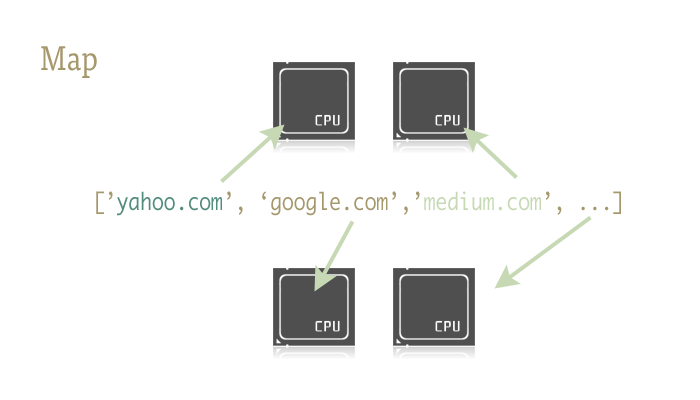一行 Python 实现并行化 -- 日常多线程操作的新思路
Python 在程序并行化方面多少有些声名狼藉。撇开技术上的问题,例如线程的实现和 GIL1,我觉得错误的教学指导才是主要问题。常见的经典 Python 多线程、多进程教程多显得偏“重”。而且往往隔靴搔痒,没有深入探讨日常工作中最有用的内容。
传统的例子
简单搜索下“Python 多线程教程”,不难发现几乎所有的教程都给出涉及类和队列的例子:
#Example.py
'''
Standard Producer/Consumer Threading Pattern
'''import time
import threading
import Queue class Consumer(threading.Thread): def __init__(self, queue): threading.Thread.__init__(self)self._queue = queue def run(self):while True: # queue.get() blocks the current thread until # an item is retrieved. msg = self._queue.get() # Checks if the current message is # the "Poison Pill"if isinstance(msg, str) and msg == 'quit':# if so, exists the loopbreak# "Processes" (or in our case, prints) the queue item print "I'm a thread, and I received %s!!" % msg# Always be friendly! print 'Bye byes!'def Producer():# Queue is used to share items between# the threads.queue = Queue.Queue()# Create an instance of the workerworker = Consumer(queue)# start calls the internal run() method to # kick off the threadworker.start() # variable to keep track of when we startedstart_time = time.time() # While under 5 seconds.. while time.time() - start_time < 5: # "Produce" a piece of work and stick it in # the queue for the Consumer to processqueue.put('something at %s' % time.time())# Sleep a bit just to avoid an absurd number of messagestime.sleep(1)# This the "poison pill" method of killing a thread. queue.put('quit')# wait for the thread to close downworker.join()if __name__ == '__main__':Producer()
哈,看起来有些像 Java 不是吗?
我并不是说使用生产者/消费者模型处理多线程/多进程任务是错误的(事实上,这一模型自有其用武之地)。只是,处理日常脚本任务时我们可以使用更有效率的模型。
问题在于…
首先,你需要一个样板类;
其次,你需要一个队列来传递对象;
而且,你还需要在通道两端都构建相应的方法来协助其工作(如果需想要进行双向通信或是保存结果还需要再引入一个队列)。
worker 越多,问题越多
按照这一思路,你现在需要一个 worker 线程的线程池。下面是一篇 IBM 经典教程中的例子——在进行网页检索时通过多线程进行加速。
#Example2.py
'''
A more realistic thread pool example
'''import time
import threading
import Queue
import urllib2 class Consumer(threading.Thread): def __init__(self, queue): threading.Thread.__init__(self)self._queue = queue def run(self):while True: content = self._queue.get() if isinstance(content, str) and content == 'quit':breakresponse = urllib2.urlopen(content)print 'Bye byes!'def Producer():urls = ['http://www.python.org', 'http://www.yahoo.com''http://www.scala.org', 'http://www.google.com'# etc.. ]queue = Queue.Queue()worker_threads = build_worker_pool(queue, 4)start_time = time.time()# Add the urls to processfor url in urls: queue.put(url) # Add the poison pillvfor worker in worker_threads:queue.put('quit')for worker in worker_threads:worker.join()print 'Done! Time taken: {}'.format(time.time() - start_time)def build_worker_pool(queue, size):workers = []for _ in range(size):worker = Consumer(queue)worker.start() workers.append(worker)return workersif __name__ == '__main__':Producer()
这段代码能正确的运行,但仔细看看我们需要做些什么:构造不同的方法、追踪一系列的线程,还有为了解决恼人的死锁问题,我们需要进行一系列的 join 操作。这还只是开始……
至此我们回顾了经典的多线程教程,多少有些空洞不是吗?样板化而且易出错,这样事倍功半的风格显然不那么适合日常使用,好在我们还有更好的方法。
何不试试 map
map 这一小巧精致的函数是简捷实现 Python 程序并行化的关键。map 源于 Lisp 这类函数式编程语言。它可以通过一个序列实现两个函数之间的映射。
urls = ['http://www.yahoo.com', 'http://www.reddit.com']results = map(urllib2.urlopen, urls)
上面的这两行代码将 urls 这一序列中的每个元素作为参数传递到 urlopen 方法中,并将所有结果保存到 results 这一列表中。其结果大致相当于:
results = []
for url in urls: results.append(urllib2.urlopen(url))
map 函数一手包办了序列操作、参数传递和结果保存等一系列的操作。
为什么这很重要呢?这是因为借助正确的库,map 可以轻松实现并行化操作。
在 Python 中有个两个库包含了 map 函数: multiprocessing 和它鲜为人知的子库 multiprocessing.dummy.
这里多扯两句: multiprocessing.dummy? mltiprocessing 库的线程版克隆?这是虾米?即便在 multiprocessing 库的官方文档里关于这一子库也只有一句相关描述。而这句描述译成人话基本就是说:"嘛,有这么个东西,你知道就成."相信我,这个库被严重低估了!
dummy 是 multiprocessing 模块的完整克隆,唯一的不同在于 multiprocessing 作用于进程,而 dummy 模块作用于线程(因此也包括了 Python 所有常见的多线程限制)。
所以替换使用这两个库异常容易。你可以针对 IO 密集型任务和 CPU 密集型任务来选择不同的库。2
动手尝试
使用下面的两行代码来引用包含并行化 map 函数的库:
from multiprocessing import Pool
from multiprocessing.dummy import Pool as ThreadPool
实例化 Pool 对象:
pool = ThreadPool()
这条简单的语句替代了 example2.py 中 build_worker_pool 函数 7 行代码的工作。它生成了一系列的 worker 线程并完成初始化工作、将它们储存在变量中以方便访问。
Pool 对象有一些参数,这里我所需要关注的只是它的第一个参数:processes. 这一参数用于设定线程池中的线程数。其默认值为当前机器 CPU 的核数。
一般来说,执行 CPU 密集型任务时,调用越多的核速度就越快。但是当处理网络密集型任务时,事情有有些难以预计了,通过实验来确定线程池的大小才是明智的。
pool = ThreadPool(4) # Sets the pool size to 4
线程数过多时,切换线程所消耗的时间甚至会超过实际工作时间。对于不同的工作,通过尝试来找到线程池大小的最优值是个不错的主意。
创建好 Pool 对象后,并行化的程序便呼之欲出了。我们来看看改写后的 example2.py
import urllib2
from multiprocessing.dummy import Pool as ThreadPool urls = ['http://www.python.org', 'http://www.python.org/about/','http://www.onlamp.com/pub/a/python/2003/04/17/metaclasses.html','http://www.python.org/doc/','http://www.python.org/download/','http://www.python.org/getit/','http://www.python.org/community/','https://wiki.python.org/moin/','http://planet.python.org/','https://wiki.python.org/moin/LocalUserGroups','http://www.python.org/psf/','http://docs.python.org/devguide/','http://www.python.org/community/awards/'# etc.. ]# Make the Pool of workers
pool = ThreadPool(4)
# Open the urls in their own threads
# and return the results
results = pool.map(urllib2.urlopen, urls)
#close the pool and wait for the work to finish
pool.close()
pool.join()
实际起作用的代码只有 4 行,其中只有一行是关键的。map 函数轻而易举的取代了前文中超过 40 行的例子。为了更有趣一些,我统计了不同方法、不同线程池大小的耗时情况。
# results = []
# for url in urls:
# result = urllib2.urlopen(url)
# results.append(result)# # ------- VERSUS ------- # # # ------- 4 Pool ------- #
# pool = ThreadPool(4)
# results = pool.map(urllib2.urlopen, urls)# # ------- 8 Pool ------- # # pool = ThreadPool(8)
# results = pool.map(urllib2.urlopen, urls)# # ------- 13 Pool ------- # # pool = ThreadPool(13)
# results = pool.map(urllib2.urlopen, urls)
结果:
# Single thread: 14.4 Seconds
# 4 Pool: 3.1 Seconds
# 8 Pool: 1.4 Seconds
# 13 Pool: 1.3 Seconds
很棒的结果不是吗?这一结果也说明了为什么要通过实验来确定线程池的大小。在我的机器上当线程池大小大于 9 带来的收益就十分有限了。
另一个真实的例子
生成上千张图片的缩略图
这是一个 CPU 密集型的任务,并且十分适合进行并行化。
基础单进程版本
import os
import PIL from multiprocessing import Pool
from PIL import ImageSIZE = (75,75)
SAVE_DIRECTORY = 'thumbs'def get_image_paths(folder):return (os.path.join(folder, f) for f in os.listdir(folder) if 'jpeg' in f)def create_thumbnail(filename): im = Image.open(filename)im.thumbnail(SIZE, Image.ANTIALIAS)base, fname = os.path.split(filename) save_path = os.path.join(base, SAVE_DIRECTORY, fname)im.save(save_path)if __name__ == '__main__':folder = os.path.abspath('11_18_2013_R000_IQM_Big_Sur_Mon__e10d1958e7b766c3e840')os.mkdir(os.path.join(folder, SAVE_DIRECTORY))images = get_image_paths(folder)for image in images:create_thumbnail(Image)
上边这段代码的主要工作就是将遍历传入的文件夹中的图片文件,一一生成缩略图,并将这些缩略图保存到特定文件夹中。
这我的机器上,用这一程序处理 6000 张图片需要花费 27.9 秒。
如果我们使用 map 函数来代替 for 循环:
import os
import PIL from multiprocessing import Pool
from PIL import ImageSIZE = (75,75)
SAVE_DIRECTORY = 'thumbs'def get_image_paths(folder):return (os.path.join(folder, f) for f in os.listdir(folder) if 'jpeg' in f)def create_thumbnail(filename): im = Image.open(filename)im.thumbnail(SIZE, Image.ANTIALIAS)base, fname = os.path.split(filename) save_path = os.path.join(base, SAVE_DIRECTORY, fname)im.save(save_path)if __name__ == '__main__':folder = os.path.abspath('11_18_2013_R000_IQM_Big_Sur_Mon__e10d1958e7b766c3e840')os.mkdir(os.path.join(folder, SAVE_DIRECTORY))images = get_image_paths(folder)pool = Pool()pool.map(creat_thumbnail, images)pool.close()pool.join()
5.6 秒!
虽然只改动了几行代码,我们却明显提高了程序的执行速度。在生产环境中,我们可以为 CPU 密集型任务和 IO 密集型任务分别选择多进程和多线程库来进一步提高执行速度——这也是解决死锁问题的良方。此外,由于 map 函数并不支持手动线程管理,反而使得相关的 debug 工作也变得异常简单。
到这里,我们就实现了(基本)通过一行 Python 实现并行化。
一行 Python 实现并行化 -- 日常多线程操作的新思路相关推荐
- 一行 Python 实现并行化 -- 日常多线程操作的新思路 - 左手键盘,右手书 - SegmentFault...
一行 Python 实现并行化 -- 日常多线程操作的新思路 - 左手键盘,右手书 - SegmentFault
- 教你用一行Python代码实现并行(附代码)
来源:编程派 翻译:caspar 译文:https://segmentfault.com/a/1190000000414339 原文:https://medium.com/building-thing ...
- 肝!一行 Python 代码实现并行
转自:caspar segmentfault.com/a/1190000000414339 Python 在程序并行化方面多少有些声名狼藉.撇开技术上的问题,例如线程的实现和 GIL,我觉得错误的教学 ...
- 实际案例演示:一行 Python 代码实现并行
来源:caspar segmentfault.com/a/1190000000414339 Python 在程序并行化方面多少有些声名狼藉.撇开技术上的问题,例如线程的实现和 GIL,我觉得错误的教学 ...
- multiprocessing python_一行 Python 代码实现并行
译者:caspar 译文: https://segmentfault.com/a/1190000000414339 原文: https://medium.com/building-things-on- ...
- python paramiko并发_使用Python paramiko模块利用多线程实现ssh并发执行操作
1.paramiko概述 ssh是一个协议,OpenSSH是其中一个开源实现,paramiko是Python的一个库,实现了SSHv2协议(底层使用cryptography). 有了Paramiko以 ...
- python多线程读取数据库数据_python多线程操作MySQL数据库pymysql
python多线程操作MySQL数据库pymysql 项目中使用多线程操作数据库提示错误:pymysql.err.InterfaceError: (0, "),原因是pymysql的exec ...
- python多线程读取数据库数据_Python基于多线程操作数据库相关知识点详解
Python基于多线程操作数据库相关问题分析 本文实例分析了Python多线程操作数据库相关问题.分享给大家供大家参考,具体如下: python多线程并发操作数据库,会存在链接数据库超时.数据库连接丢 ...
- python的多线程适合计算密集操作_Python 多线程操作学习
Python 多线程操作 什么是线程: 线程(Thread)也叫轻量级进程,是操作系统能够进行运算调度的最小单位,它被包涵在进程之中,是进程中的实际运作单位.线程自己不拥有系统资源,只拥有一点儿在运行 ...
最新文章
- 10大经典排序算法,20+张图就搞定
- Prepare the Knowledge Base for Success
- w ndows7防火墙文件名,Windows7中的防火墙是什么? 爱问知识人
- Spring MVC 实践笔记
- (待解决!)jmx在PetClinic中的应用
- HeadFirst设计模式-命令模式
- pytorch实现猫狗分类+数据集
- 不断网情况下,如何关闭红蜘蛛多媒体网络教室
- 计算机程序可以通过删除卸载嘛,怎么彻底卸载电脑软件程序多种方法
- 有哪些高质量的图片网站(社区)推荐?
- 优酷动漫押注“新国风”,能否追回被B站、腾讯赶超的那些年?
- 大白菜u盘装win10步骤图解
- 搞事课堂 C++格式化硬盘
- 都是古人抓紧时间发奋苦读的典范
- chrome android 中文版下载,Chrome浏览器安卓版
- ubuntu下进行流量监控软件nethogs安装
- 3月广州IT媒体杀人游戏比赛,就在本周五晚
- matlab中输入十六进制数
- c linux ping 实现
- Windows快捷命令-应急响应

